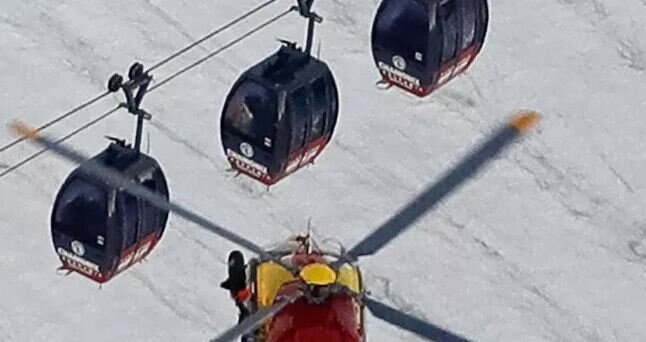
An EC-135 helicopter operated by the French Societe’ Civile hovers, Friday, Sept. 9, 2016, near three cars of the Panoramic Mont Blanc cable car where tourists were trapped after it stalled around 4 p.m. (1400 GMT) on Thursday, when its cables reportedly tangled. (AP Photo/Luca Bruno)
CHAMONIX, France — Dozens of tourists, including three children, were rescued Friday after being trapped overnight in cable cars dangling above the slopes of Mont Blanc in the Alps.
Their return to land ended an extraordinarily complex and vertiginous rescue effort over two days amid the spectacular but dangerous landscape of Western Europe’s tallest mountains.
The last passengers were brought down Friday morning, after emergency workers managed to untangle cables that had jammed Thursday, according to the mayor of the French town of Chamonix.
With the cables now straightened, the cable cars were able to resume their journey Friday, at very slow speeds and under close surveillance, and delivered the passengers to the nearest ground stations, Mayor Eric Fournier said. The passengers were then flown by helicopter to Chamonix and the Italian town of Courmayeur.
The ordeal began Thursday afternoon, when cables on the Panoramic Mont Blanc cable car service got twisted, trapping 110 people in a string of cars at 3,800 metres altitude.
French and Italian helicopters flew in rescuers who dropped down on cables onto the tops of the cars, and lifted out passengers one by one.
“The extent of this rescue operation is simply unbelievable,” said Col. Frederic Labrunye, commander of the provincial gendarmerie group of Haute-Savoie. “By the volume of people to rescue – we rarely rescue 110 people at the same time in high mountain – and by the environment in which it happens … in the heart of one of the largest glaciers in Europe, over a distance of five kilometres of cable with 36 cabins.”
Helicopters had to carefully fly over the cables, which is risky itself, then lower a rescuer onto an area “not larger than a table,” strap on passengers one by one and extract them, he said, describing it as “air surgery.”
Then fog descended and darkness started to fall, and authorities called off the helicopter rescue.
So they switched to “Plan B,” Fournier said.
Mountain guides identified the cable cars closest to the ground, and used climbing ropes to carry passengers to the surface of the glacier below, one by one.
From there, rescuers brought the passengers by foot to the nearest mountain station.
Fournier said 65 people were rescued overall Thursday, and another 12 were brought down overnight using “Plan B.”
The remaining 33 people were in cable cars too high off the ground, so they stayed overnight. They included a seven-year-old and nine-year-old from Korea and a 10-year-old Italian child.
“They didn’t get a lot of sleep, it was a strange experience, but they were warm under blankets and with their families,” Fournier said.
Five rescuers stayed overnight in the cable cars and provided blankets, food and water to help weather the chilly mountain night-time conditions.
Kathy Cook, a tourist from Michigan who was carried down to the ground by a rescuer after almost 10 hours aloft, called it “really quite an experience.”
“The helicopter rescue failed because the fog moved in, so we had to just wait and then they decided they could belay us safely to the ground, and we walked up the glacier to the hut,” she said upon arrival in Courmayeur.
The cable car, which offers spectacular up-close views of Western Europe’s tallest mountains and deep valleys below, connects the Aiguille de Midi peak in France, at 3,842 metres (12,605 feet), to Pointe Helbronner in Italy, at 3,462 metres (11,358 feet).





